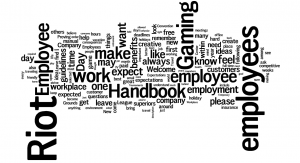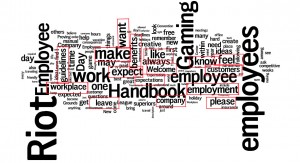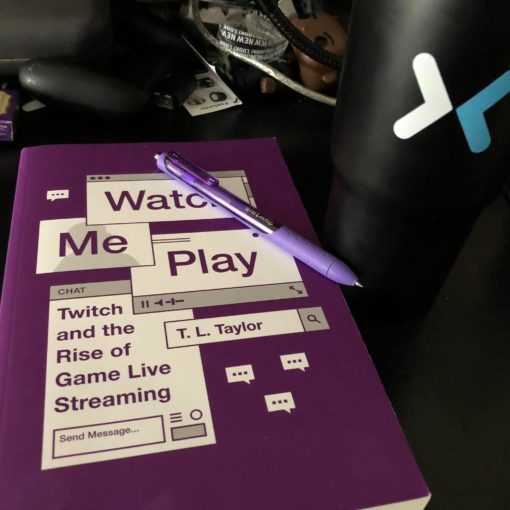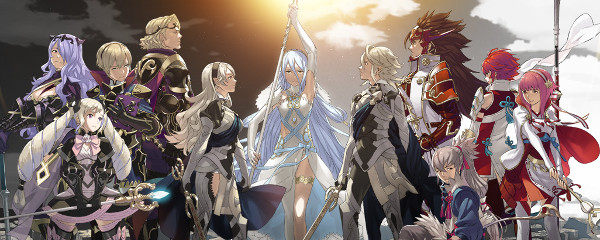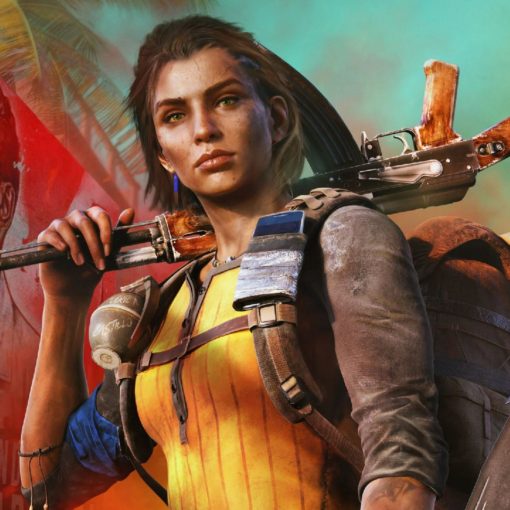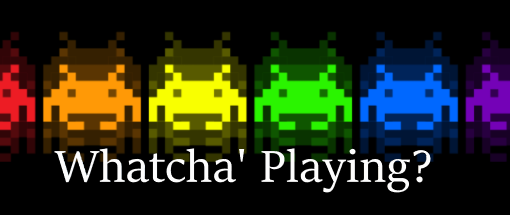This is part of an ongoing series where I visually analyze video game company policy. It is incomplete when taken out of context from the rest of my diss and argument, but still, I think, interesting. With this work, I hope to be able to find an implementable way companies can begin to change the identities and stories of their companies, which I believe will in turn begin to change employees behavior, which will change the games, and through all this it will create a better environment for women in the games industry. Brenton Faber writes, “Change is inherently a discursive project. This means that change is restricted by the structures of language and by the conventions of language use. Change will be a product of what can be legitimately said (or written) in a specific context at a specific moment in time.” With this in mind, I seek to create change by analyzing, critiquing, and then suggesting change of company-endorsed and publicly available documents.
One of the things that makes Riot’s handbook look so different from EA and Blizzard is that they have organized it into a guide rather than a traditional policy. As can be seen in the word frequency chart above, the most used words don’t look all that different on the surface, but the content is significantly different. Riot opens it’s handbook by saying, “These guidelines are here to better understand the privileges and obligations that are allowed during employment with Riot Gaming Company” (8). They go on to specify that their behavior guidelines are in effect while at work, during company travel, at gaming events, and in meetings. This is significant, because much of the harassment and assault issues in the industry occur at cons. The cons often do not have a code of conduct for participants, and thus even if acting as an ambassador of a particular company, employees are in a kind of ephemeral zone between being on the clock and being off. Riot, quite uniquely, defines up front, on the first page of content, that while employed at Riot you are always bound by their policies: “Tourneys are fun and exciting but are still considered the workplace. Workplace etiquette and professionalism is expected and remembering the image of Riot is to be exemplified through our employees” (12). (On a personal note, that’s pretty damn cool.)
A cursory analysis of the language they employ to protect their workers seems disappointing. They do not talk about harassment or sexual offensive. Upon a deeper analysis, however, the handbook does cover these issues but in a more specific way. Among their list of inappropriate behavior, they list “bothering others,” “excessive/unnecessary noises,” “screaming foul languages,” “disrespecting employees,” “degrading customers and/or your coworkers,” “inappropriate behavior,” and so on. Rather than use the typical legalese, they narrate what is and is not appropriate. They even talk about how shy people or new employees can boost their confidence and talk to others at cons.
Another crucial element that Riot includes in their policy, that is missing in both EA’s and Blizzard’s policies, is a concrete path to follow when you feel someone has violated the code of conduct. Bliazzard and EA both say to contact the “appropriate person” in the event there has been a violation. Riot, on the other hand, cites the name and contact of the “Employee Advising Associate” that should be contact in case of questions or violations. When new to a company, it can be difficult if even possible to figure out whom to contact for things like harassment. Further, it can be dangerous to ask a fellow employee whom to contact if you’re being harassed (as simply asking the question can raise a flag and compromise confidentiality). As Emillio Castilla points out in his study of meritocratic workplaces, transparency is one of the only ways to ensure an equitable workplace.
An analysis of the mid-level words in the wordle also paints a different picture than EA or Blizzard.
Words that didn’t show up on other companies’ charts at all, like “know” and “feel,” feature fairly prominently in Riot’s frequency visual. Other words, like “policy,” “property,” and “compliance” are markedly absent. Of course, it is possible that Riot provides a different document that is more traditional to its employees, however this is what is publicly available.
Riot Games crushes the most popular online multiplayer games like Call of Duty and World of Warcraft,[1] boasting over 12 million daily log ons, whereas COD and WoW are about 3 million. Finding finances statistics are difficult, but I did find one article that puts the per quarter revenue for the company who bought Riot in 2011 around 1.7 billion. Just check out this infographic, courtesy of Cody Reimer: http://majorleagueoflegends.s3.amazonaws.com/lol_infographic.png
The section word count visual for Riot’s handbook is slightly less impactful, as they have esoteric names for their sections. Rather than having sections on conflicts of interest and confidentiality, they focus on how meetings work and on valuing your and your coworkers expertise. It is somewhat difficult to analyze this visually, as it is so unique.
So the big question, which I’m able to ask now thanks to some interesting feedback provided by Don on my Blizzard analysis blog: is this view of their policy reflected in their public behavior? In other words, do company policies seem to be reflected in the company’s public persona? Cody Reimer at Games and Academia follows Riot Games and their most popular game, League of Legends. He reports:
In my previous posts I wrote about how transparency and community outreach are vital for successful living games. Relying on the playerbase to help find bugs, suggest balance fixes, and lobby for content means the development team can iterate more quickly and more successfully; building in transparency into their post-release design ensures that players feel valued and see their work in action. All of this helps improve the game. Riot excels at both transparency and community outreach. The studio interacts with their players through their official forums, but also through Reddit, where designers pop in to address concerns and host AMAs (Ask Me Anything). Riot releases patch notes like many other developers of living games, but the patch notes are often accompanied by a video featuring prominent designers who explain their rationale for the upcoming changes.
Beyond transparency, Riot also upholds accountability for its employees and representatives. Over the past number of months we’ve seen official, public statements concerning high-profile bans. Professional players represent Riot to the public, and those who violate Riot’s “Summoner’s Code [of conduct]” (League players are called summoners), are not immune to a thwack from the ban-stick. The public nature of these bans exists, in my mind, based on their tone, less to make an example of the violators and more to demonstrate that Riot holds everyone accountable. Such accountability is admirable, especially in light of the refrain that LoL is a great game with a terrible community. Riot’s attempts at cleaning up the game include hiring PhDs to focus on and improve/incentivize player behavior, implementing features like the Tribunal and Honor system to gamify good sportsmanship.
With large companies of course you will always have examples of good and bad behavior. But there seems to be a large gap between a company like EA, voted worst company in the world, and Riot Games, which inspires scholars like Cody to study their workplace practices. Likewise, there is a major difference in policies, with EA spending more time on how to obtain a waiver for the code of conduct than on harassment and Riot demanding that their employees are under their code of conduct at all times and going into details about inappropriate behavior. In the end, I think that Riot’s handbook, which not perfect by any means, shows a positive step toward the kinds of documents that create a new identity, a new story for the industry.

